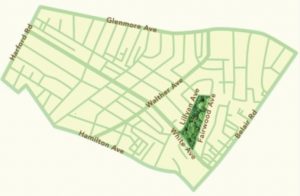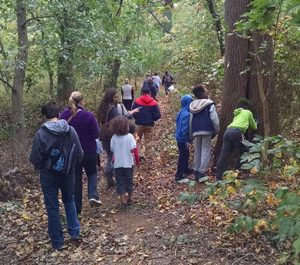By Katie Lautar
The Maryland Community Naturalist Network (MCNN) is in the business of revealing the magic of the natural world in Baltimore’s backyards and forest floors. Each second Saturday, they host a walk. Last month, they partnered with the resident leaders at Fairwood Forest, a four-acre forest in the Glenham Belhar neighborhood.
When the MCNN visits a site, they bring members of their team – geologists, forest experts, and plant biologists – and meet with key leaders from that neighborhood. They empower residents with site-specific information about everything from the species of trees throughout a forest patch to the plants growing from the cracks in the sidewalk. The MCNN provides the same level of expertise whether three or thirty neighbors join.
Charlie Davis, one of the founders, has consulted on much of Baltimore Green Space’s forest patch work, including identifying plants remotely for our field research. Last month, Charlie and his wife, Linda Davis, met a handful of community folks at the edge of the Fairwood Forest and began the nature walk by examining a leaf, which led to a whole universe of new understanding about our surroundings. Linda paused periodically to identify the birds singing and mimic their calls. (Can you make the sound of the Baltimore oriole? Hang out with Linda and you may learn it, along with many others!) In addition to identifying birds, Charlie and Linda identified many of more than 23 tree species in this forest, such as pignut hickory and the American hornbeam, also known as a blue beech or musclewood. During the walk, the community leaders also learned how to use I-Naturalist, where they recorded all the plants they identified – click the link and you’ll see a map of what they identified!

This is a map of Fairwood Forest.
The most exciting thing they identified by far was when the group took a moment to pause at an uprooted tree with a 4-ft diameter mud platter surrounding its root system. There were bees buzzing in and out of holes in the platter – a colony of solitary mining bees! Most of us are familiar with the honey bees that live cooperatively in hives, but the vast majority of bees are solitary bees, living alone in holes they dig and fill with bee eggs and collected pollen and nectar. Solitary bees are often more efficient at pollinating than your average honey bee, so take note next time you see bees coming out of the soil – they could just as important for pollination as the honey bee!
Eugenia Argires, forest steward of Fairwood Forest, relayed her awe about the MCNN’s technical vocabulary and engaging presentation skills, saying, “Their knowledge was so expansive. The Latin terms and their scientific knowledge never got in the way of the wonderment. It just enhanced it.” We encourage you to engage the “wonderment” at their next gathering. You can find out more about it by joining the MCNN Facebook group here.
Also, Fairwood Forest is a few steps away from being preserved. They are currently raising funds to cover the transfer costs of the land and are just $2,000 away from their goal. You can donate to preserve this land here.*Special thanks to Eugenia Argires for providing all of the details that helped us paint this picture for our article.

This is a photo from a previous forest walk in Fairwood Forest.
Be the first to hear about exciting events, news, and opportunities.
[email protected]
(813) 530-8166
2100 Liberty Heights Avenue
Baltimore MD 21217
Facebook | Instagram | Twitter